- Bernard Preston homepage
- Honey Mead
- How to Read a Wine Hydrometer
How to read a wine hydrometer
How to read a wine hydrometer also enables a brewer to determine the alcohol concentration of a mead or beer. Knowing that fermentation is complete means one can bottle safely.
Brewing one's own alcohol is not without risks. For example there is the danger of bursting bottles sending out a cloud of glass shrapnel that can do severe bodily harm. Knowing how to read a wine hydrometer is part of the solution; for meads, ales and lagers too.
Reading a hydrometer is none too easy.
Archimedes
The hydrometer goes back to a Greek genius by the name of Archimedes[1]; in the 3rd century BC. Today we are using it to measure the specific gravity of our mead; how much honey remains unfermented.
Despite having a degree majoring in mathematics and physics I confess I too had difficulty reading a wine hydrometer initially; it's all about decimals.
So I set about seeing if I could make it simple; the KISS principle.
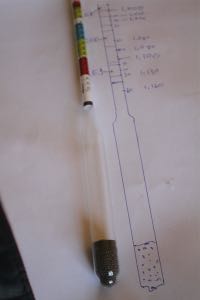
So the first thing is to accept that you are not all alone in having difficulties of how to read a wine hydrometer. I get questions from fellow meaders.
Let's focus in a bit.
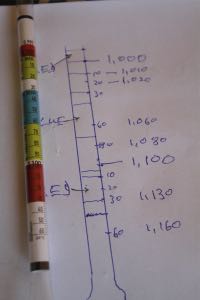
Start by finding the 1.000 and 1.100 marks. Three decimals means we are dividing the distance between them into thousandths.
1.000 is the specific gravity (SG) of pure water; it means there are no sugars left in solution. Fermentation is complete.
There are 100 thousandths between 1.000 and 1.100.
On the left you will see readings of 10, 20 and 30; these refer to the number of thousandths.
So 10 represents ten-thousandths; 0.010.
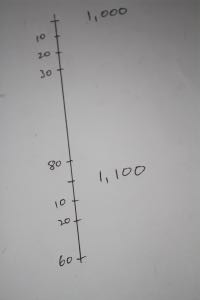
So the 10 mark on the left really means 1.000 + 0.010 = 1.010.
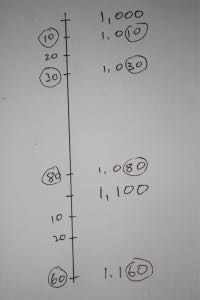
Between 0 and 10 on the scale you'll see it is divided by 5 little marks; each one represents two thousandths (0.002).
So the 2 I've circled below (not shown on the hydrometer) represents two thousandths above 1.000. (i.e. 1.002).
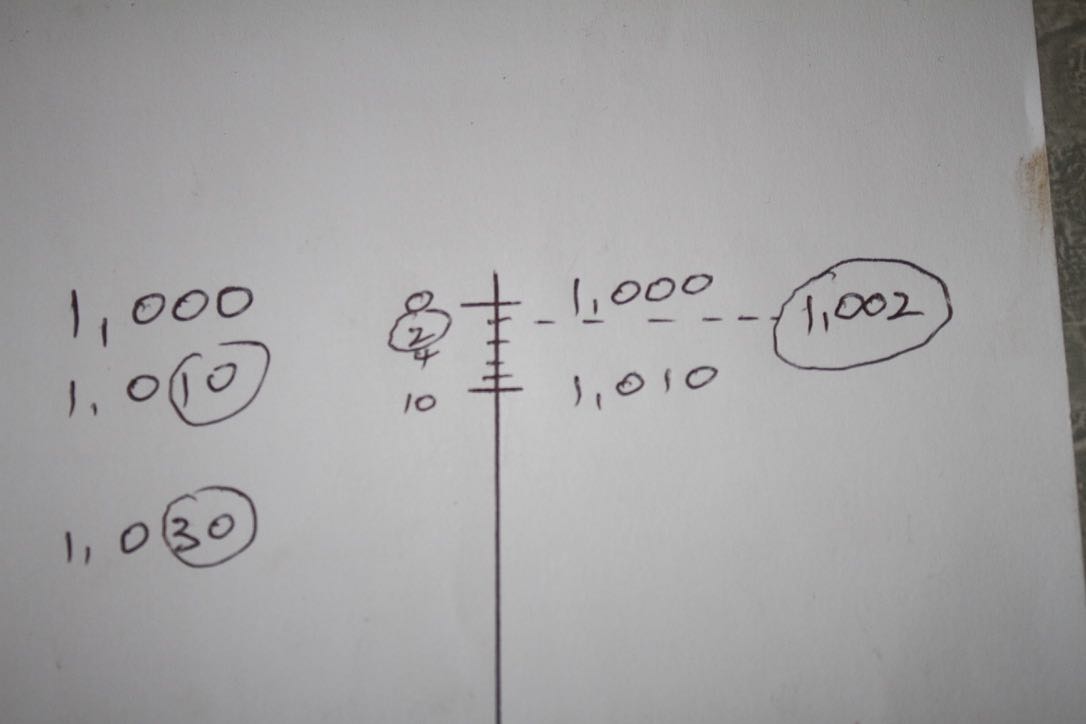
And now finally we can measure the SG to the nearest thousandth.
This may be an easier way to consider the readings. Notice two things.
- The readings on the left lower down have been added onto 100 to give continuous values from 0 to 160.
- The ABV on the right is an approximate value; it will depend on your final SG.
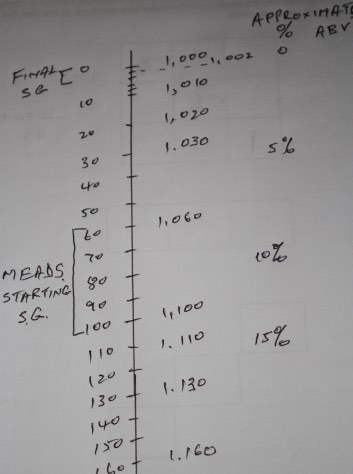
Meads will commonly have a starting SG between 60 and 100; and a FG of about 4.
I hope this is clear as mead and not as murky as mud!
Gabriel's mead hydrometer reading
So what is Gabriel's mead hydrometer reading?
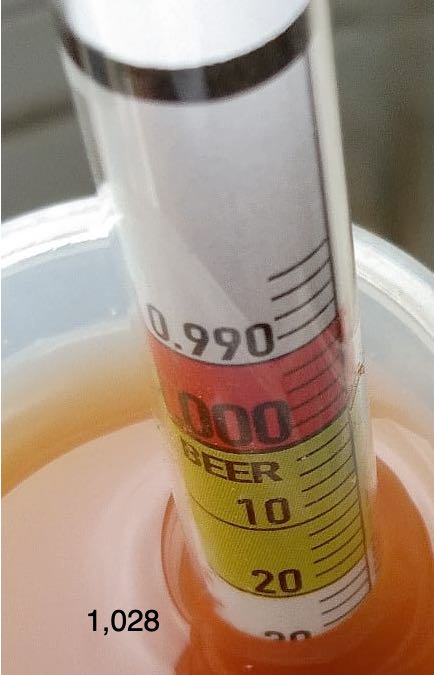
It's somewhere between 26 and 30 thousandths; plus 1.000. My best guess is 1.028. There is still quite a lot of honey left in solution; fermentation is not complete. Bottling now would be dangerous.
If there's a lot of sedimentation at the bottom and you want to use the carboy for the next brew, one could rack it off into demijohns; but an air-trap is still needed.
Fragile
The wine hydrometer is a particularly fragile device; treat it mindfully. Most meaders have broken one or two.
The wine hydrometer is an important part of the basic mead equipment.
Alcohol by volume (ABV)
To determine the alcohol by volume of my cherry guava mead, I needed both the starting and the final values of the specific gravity; generally known as the SG and the FG.
The formula for the ABV is as follows.
(SG - FG) / 0.776 = ABV
For the cherry guava mead the SG was 1.085; and the FG was 1.004.
Then the ABV = (1.085 - 1.004) / 0.776
= 0.081 / 0 .776
= 0.104
Multiply by 100 to bring to a percentage. 10.4%.
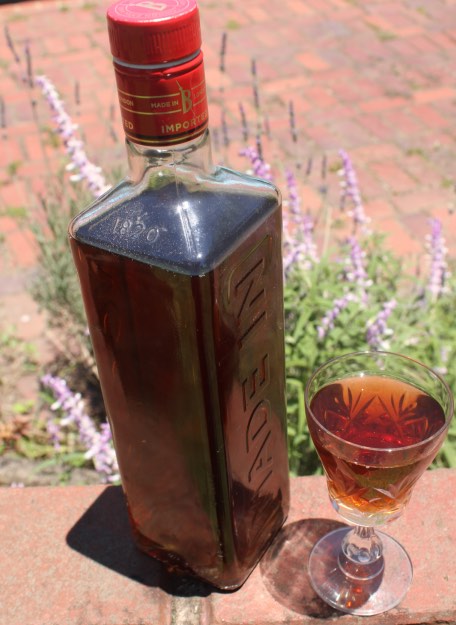
This cherry guava mead is about 9 months since the fermentation began; it hasn't cleared completely yet and small bits of wax can be seen floating in the neck. To win competitions more time needs to pass and further rackings.
It is probably my favourite melomel. Using raw fruit was decidedly better than that which had been boiled and the juice then extracted; as is done when making a jelly.
Mind you the peppadew honey mead is a close contender.
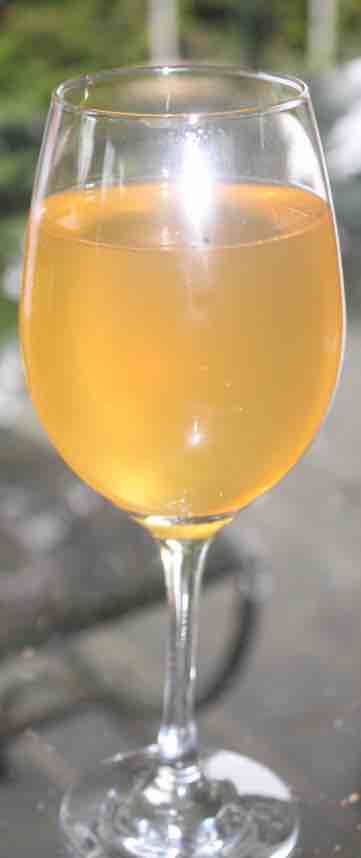
Probiotic
There is considerable virtue in drinking meads that have not cleared completely; they still contain living yeast cells. Unpasteurised and with no preservatives they are today being called "natural" wines.
Natural wines, beers and meads unlike commercial alcohol, in moderation actually contribute to wellness.
As little as one glass of commercial wine per week actually causes breast and presumably other malignant tumours.
Most ancient cultures enjoyed fermented foods of one sort or another; science has now clearly shown that many friendly viruses, bacteria and yeast cells from our food and drink are vital for wellness.
A far simpler probiotic to make at home is kefir; it's like a very strong yoghurt.
How to read a wine hydrometer
How to read a wine hydrometer helps to decide if brewing is complete; and to determine the alcohol concentration.
When browsing use right click and "Open Link in New Tab" or you may get a bad gateway signal.
Newsletter
Our newsletter is entitled "create a cyan zone" at your home, preserving both yourself and Mother Earth for future generations; and the family too, of course. We promise not to spam you with daily emails promoting various products. You may get an occasional nudge to buy one of my books.
Here are the back issues.
- Lifestyle and ideal body weight
- What are ultra-processed foods?
- Investing in long-term health
- Diseases from plastic exposure
- Intensive lifestyle management for obesity has limited value
- A world largely devoid of Parkinson's Disease
- The impact of friendly bacteria in the tum on the prevention of cancer
- There's a hole in the bucket
- Everyone is talking about weight loss drugs
- Pull the sweet tooth
- If you suffer from heartburn plant a susu
- Refined maize meal and stunting
- Should agriculture and industry get priority for water and electricity?
- Nature is calling
- Mill your own flour
- Bake your own sourdough bread
- Microplastics from our water
- Alternative types of water storage
- Wear your clothes out
- Comfort foods
- Create a bee-friendly environment
- Go to bed slightly hungry
- Keep bees
- Blue zone folk are religious
- Reduce plastic waste
- Family is important
- What can go in compost?
- Grow broad beans for longevity
- Harvest and store sunshine
- Blue zone exercise
- Harvest and store your rainwater
- Create a cyan zone at your home
Did you find this page interesting? How about forwarding it to a friendly book or food junkie? Better still, a social media tick would help.
- Bernard Preston homepage
- Honey Mead
- How to Read a Wine Hydrometer
Address:
56 Groenekloof Rd,
Hilton, KZN
South Africa
Website:
https://www.bernard-preston.com